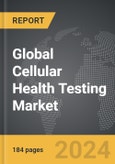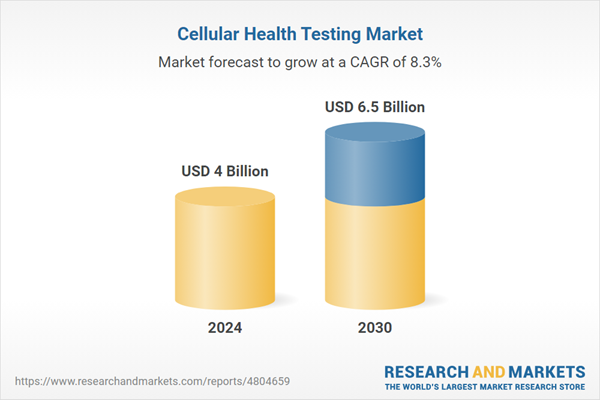The global market for Cellular Health Testing was valued at US$4.0 Billion in 2024 and is projected to reach US$6.5 Billion by 2030, growing at a CAGR of 8.3% from 2024 to 2030. This comprehensive report provides an in-depth analysis of market trends, drivers, and forecasts, helping you make informed business decisions. The report includes the most recent global tariff developments and how they impact the Cellular Health Testing market.
Segments: Type (Single-Test Panels, Multi-Test Panels); Sample Type (Blood Samples, Other Sample Types); Collection Site (At-Home, In-Office, Other Collection Sites).
Geographic Regions/Countries: World; United States; Canada; Japan; China; Europe (France; Germany; Italy; United Kingdom; and Rest of Europe); Asia-Pacific; Rest of World.
The analysts continuously track trade developments worldwide, drawing insights from leading global economists and over 200 industry and policy institutions, including think tanks, trade organizations, and national economic advisory bodies. This intelligence is integrated into forecasting models to provide timely, data-driven analysis of emerging risks and opportunities.
Global Cellular Health Testing Market - Key Trends and Drivers Summarized
How Is Cellular Health Testing Transforming Biomedical and Clinical Research?
Cellular health testing is playing an increasingly critical role in biomedical and clinical research, offering deeper insights into how cells function, respond to treatments, and age. These tests assess various cellular functions, such as energy production, oxidative stress levels, and DNA damage, providing a comprehensive understanding of cell viability and vitality. Cellular health testing is widely used in research areas like oncology, metabolic disorders, and aging, where cellular function is central to disease progression. In cancer research, for instance, testing the health of tumor cells can help determine how they respond to treatments, guiding the development of more targeted therapies. Similarly, in the study of metabolic diseases, cellular health tests are used to monitor mitochondrial function, providing crucial information on how cells produce and manage energy. As the focus in medicine shifts toward preventative care and early intervention, cellular health testing is becoming a valuable tool for identifying underlying issues before they manifest as symptoms, leading to better outcomes for patients and more personalized approaches to healthcare.Why Is Cellular Health Testing Critical in Drug Development and Disease Management?
Cellular health testing is essential for drug development and disease management because it allows researchers and clinicians to evaluate how cells respond to different therapeutic interventions, stressors, and environmental factors. In drug development, these tests are used to assess whether a drug enhances or impairs cellular function, offering early insights into its therapeutic potential or toxicity. Cellular health assays, which evaluate metrics like ATP production, reactive oxygen species (ROS) generation, and apoptosis, help determine whether a compound supports healthy cell function or triggers cell death. This is particularly important in oncology, where drugs aim to selectively kill cancer cells while sparing healthy ones. In chronic disease management, cellular health testing can be used to monitor disease progression by tracking changes in cellular metabolism, inflammation, or DNA integrity. For example, mitochondrial health tests are used in neurodegenerative diseases like Parkinson’s and Alzheimer’s to understand how cellular energy production declines over time, providing targets for potential therapeutic interventions. As healthcare moves towards more personalized approaches, cellular health testing will continue to be vital for monitoring individual responses to treatments and managing long-term health conditions.How Are Technological Innovations Enhancing Cellular Health Testing?
Technological advancements are significantly enhancing the precision and scope of cellular health testing, enabling researchers to capture more detailed and dynamic data on cell function. One major breakthrough is the use of real-time imaging and live-cell analysis technologies, which allow scientists to monitor cellular health continuously over time without disrupting the cells. This has led to a better understanding of how cells behave under different conditions, such as drug exposure or oxidative stress, offering a more complete picture of cellular responses. High-throughput screening platforms have also revolutionized the field, enabling laboratories to conduct cellular health tests on thousands of samples simultaneously. These advancements are particularly valuable in drug discovery, where rapid, large-scale testing is essential for identifying promising therapeutic candidates. Additionally, advances in metabolomics and single-cell analysis technologies are providing more granular data on cellular health by measuring metabolic changes and assessing the health of individual cells within a population. With the rise of 3D cell cultures and organ-on-a-chip technologies, cellular health testing is also becoming more relevant for modeling complex tissues and organs, making it possible to study cell behavior in more physiologically relevant environments. These innovations are pushing the boundaries of what is possible in cellular health testing, leading to more accurate and actionable insights.What Are the Key Factors Growth in the Cellular Health Testing Market?
The growth in the cellular health testing market is driven by several factors, including the rising demand for personalized medicine, the increasing focus on preventative healthcare, and advancements in testing technologies. One of the key drivers is the growing recognition that cellular health is a critical indicator of overall health and disease risk, which has led to greater adoption of these tests in both research and clinical settings. As healthcare shifts towards more individualized approaches, cellular health testing is becoming a cornerstone of personalized medicine, helping doctors and researchers understand how a patient’s cells function and respond to treatments on a more personal level. Technological innovations, such as real-time cell analysis, high-throughput testing platforms, and advanced imaging techniques, are making cellular health testing more accessible and efficient, driving its use in drug discovery and development. The rising prevalence of chronic diseases like diabetes, cardiovascular conditions, and neurodegenerative disorders is also contributing to market growth, as these conditions often involve disruptions in cellular function. Moreover, consumer interest in wellness and longevity has led to a growing demand for cellular health testing as a tool for monitoring aging and developing strategies to improve long-term health. With increasing investment in life sciences research, expanding applications in clinical diagnostics, and the growing use of cellular health tests in therapeutic development, the market for cellular health testing is expected to experience robust growth in the coming years.Report Scope
The report analyzes the Cellular Health Testing market, presented in terms of units. The analysis covers the key segments and geographic regions outlined below.Segments: Type (Single-Test Panels, Multi-Test Panels); Sample Type (Blood Samples, Other Sample Types); Collection Site (At-Home, In-Office, Other Collection Sites).
Geographic Regions/Countries: World; United States; Canada; Japan; China; Europe (France; Germany; Italy; United Kingdom; and Rest of Europe); Asia-Pacific; Rest of World.
Key Insights:
- Market Growth: Understand the significant growth trajectory of the Single-test Panels segment, which is expected to reach US$3.7 Billion by 2030 with a CAGR of a 7.2%. The Multi-test Panels segment is also set to grow at 10.1% CAGR over the analysis period.
- Regional Analysis: Gain insights into the U.S. market, valued at $1.1 Billion in 2024, and China, forecasted to grow at an impressive 7.9% CAGR to reach $1.0 Billion by 2030. Discover growth trends in other key regions, including Japan, Canada, Germany, and the Asia-Pacific.
Why You Should Buy This Report:
- Detailed Market Analysis: Access a thorough analysis of the Global Cellular Health Testing Market, covering all major geographic regions and market segments.
- Competitive Insights: Get an overview of the competitive landscape, including the market presence of major players across different geographies.
- Future Trends and Drivers: Understand the key trends and drivers shaping the future of the Global Cellular Health Testing Market.
- Actionable Insights: Benefit from actionable insights that can help you identify new revenue opportunities and make strategic business decisions.
Key Questions Answered:
- How is the Global Cellular Health Testing Market expected to evolve by 2030?
- What are the main drivers and restraints affecting the market?
- Which market segments will grow the most over the forecast period?
- How will market shares for different regions and segments change by 2030?
- Who are the leading players in the market, and what are their prospects?
Report Features:
- Comprehensive Market Data: Independent analysis of annual sales and market forecasts in US$ Million from 2024 to 2030.
- In-Depth Regional Analysis: Detailed insights into key markets, including the U.S., China, Japan, Canada, Europe, Asia-Pacific, Latin America, Middle East, and Africa.
- Company Profiles: Coverage of players such as Bio-Reference Laboratories, Inc., Cell Science Systems Corp., Cleveland Heartlab, Inc., Dna Labs India, Genova Diagnostics and more.
- Complimentary Updates: Receive free report updates for one year to keep you informed of the latest market developments.
Some of the 22 companies featured in this Cellular Health Testing market report include:
- Bio-Reference Laboratories, Inc.
- Cell Science Systems Corp.
- Cleveland Heartlab, Inc.
- Dna Labs India
- Genova Diagnostics
- Immundiagnostik AG
- Laboratory Corporation of America Holdings
- Life Length
- Quest Diagnostics, Inc.
- Repeat Diagnostics Inc. (Repeat Dx)
- Segterra, Inc.
- SpectraCell Laboratories, Inc.
- Telomere Diagnostics, Inc. (Tdx)
- Zimetry LLC
Tariff Impact Analysis: Key Insights for 2025
Global tariff negotiations across 180+ countries are reshaping supply chains, costs, and competitiveness. This report reflects the latest developments as of April 2025 and incorporates forward-looking insights into the market outlook.The analysts continuously track trade developments worldwide, drawing insights from leading global economists and over 200 industry and policy institutions, including think tanks, trade organizations, and national economic advisory bodies. This intelligence is integrated into forecasting models to provide timely, data-driven analysis of emerging risks and opportunities.
What’s Included in This Edition:
- Tariff-adjusted market forecasts by region and segment
- Analysis of cost and supply chain implications by sourcing and trade exposure
- Strategic insights into geographic shifts
Buyers receive a free July 2025 update with:
- Finalized tariff impacts and new trade agreement effects
- Updated projections reflecting global sourcing and cost shifts
- Expanded country-specific coverage across the industry
Table of Contents
I. METHODOLOGYII. EXECUTIVE SUMMARY2. FOCUS ON SELECT PLAYERSIII. MARKET ANALYSISREST OF WORLDIV. COMPETITION
1. MARKET OVERVIEW
3. MARKET TRENDS & DRIVERS
4. GLOBAL MARKET PERSPECTIVE
UNITED STATES
CANADA
JAPAN
CHINA
EUROPE
FRANCE
GERMANY
ITALY
UNITED KINGDOM
REST OF EUROPE
ASIA-PACIFIC
Companies Mentioned (Partial List)
A selection of companies mentioned in this report includes, but is not limited to:
- Bio-Reference Laboratories, Inc.
- Cell Science Systems Corp.
- Cleveland Heartlab, Inc.
- Dna Labs India
- Genova Diagnostics
- Immundiagnostik AG
- Laboratory Corporation of America Holdings
- Life Length
- Quest Diagnostics, Inc.
- Repeat Diagnostics Inc. (Repeat Dx)
- Segterra, Inc.
- SpectraCell Laboratories, Inc.
- Telomere Diagnostics, Inc. (Tdx)
- Zimetry LLC
Table Information
| Report Attribute | Details |
|---|---|
| No. of Pages | 184 |
| Published | April 2025 |
| Forecast Period | 2024 - 2030 |
| Estimated Market Value ( USD | $ 4 Billion |
| Forecasted Market Value ( USD | $ 6.5 Billion |
| Compound Annual Growth Rate | 8.3% |
| Regions Covered | Global |









